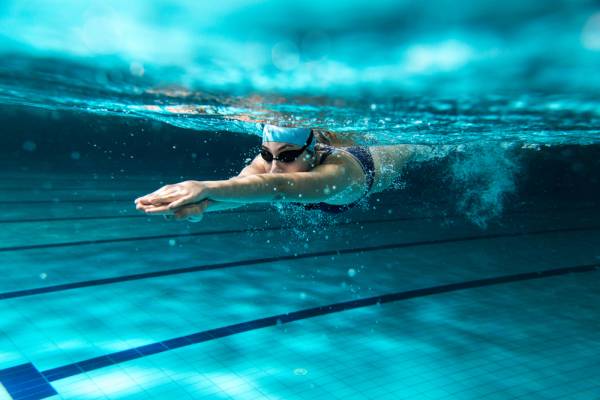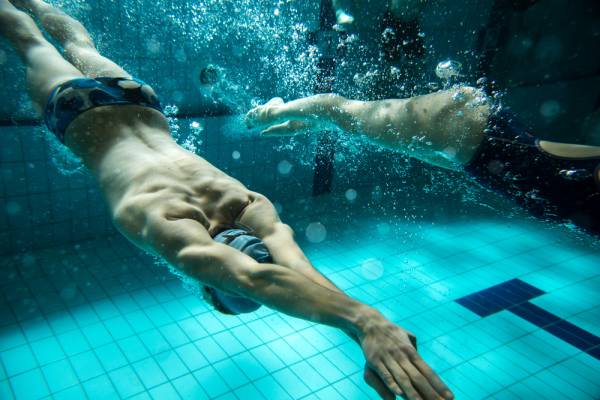If you are considering a Special Ops profession, particularly one that could involve waterborne operations, you will need to learn the modified sidestroke, also called the combat swimmer stroke.
The uniqueness of this stroke is that it can be used either with fins or without. This modified sidestroke has been unofficially nick named “the CSS” and is used during long ocean swims with fins, as well. In fact, for the BUD/S Physical Screening test, you will be tested in a 500-yard swim using an underwater recovery stroke (side stroke, breast stroke, etc.). Are you ready for that?
Getting ready to learn about Special Ops waterborne operations.
The CSS: Breaking Down the Stroke
Teaching swimming, as with many athletic movements, is nearly impossible to do with a picture and article. The video below breaks down the stroke into the following movements:
- Kick off the wall – double arm pull (breast stroke pullout)
- Recovery into the first stroke
- Top arm pull
- Bottom arm pull and breathe (inhale)
- Kick/glide and arm recovery (exhale underwater)
The movement cadence I like to use with this is: pull, breathe, kick, glide. Watch the video, as a moving picture is worth 10,000 words.
Here is a demonstration of the CSS with above-average swimmers. They do 500-yard swims in seven minutes. Notice the efficiency of each stroke.
You Have to Put in the Work
Here are the daily drills to practice to not only learn the stroke, but to get in shape for swimming (if you’re not used to swimming often). You have to practice this several days a week to master the technique and to condition yourself for Special Ops swimming.
“There is no thirty-minute gym routine that will prepare you for a day of Special Ops.”
There is no thirty-minute gym routine that will prepare you for a day of Special Ops. You have to put in the time running, rucking, swimming, lifting, and doing higher-repetition calisthenics. Combine all of these into a workout and a typical workout will last two to three hours.
If you need to prepare for more than just the swim,
click here for the full PT test prep program.
5-Day per Week Program for Training the CSS
Day 1
Technique:
- 10 kick offs / glide / double arm pull – try to get 10m or more from the wall
- 10 kick offs and recovery into the first stroke – finish the rest of the length trying the CSS
- 25m x 4 using kick board, doing the scissor kick to produce glide
Conditioning:
- 500m of CSS / freestyle – swim 25m freestyle fast / 25m CSS easy to catch breath
Day 2
Technique:
- Efficiency – counting strokes per length (count your breaths per length as you will only breathe once per stroke)
- 10 x 25m of kick offs / glide / double arm pull / recovery – swim to other wall counting breaths. Shoot for 5-7 strokes per length. Above average is 4-5 strokes per length
Conditioning:
- Timed 500m CSS or Freestyle – which ever feels more comfortable.

Day 3
Technique:
- 5 kick offs / glide / double arm pull – try to get 10m or more from the wall
- 5 kick offs and recovery into the first stroke – finish the rest of the length trying the CSS
- Focus on arm pulls – big, strong pulls. Think of your arm as an oar in the water. Get it near vertical and pull your body through the stroke
Conditioning:
- 5 x 100m sprints using free style stroke – rest with easy 50m CSS in between each 100m (active rest)
Day 4
Technique:
- 5 kick offs / glide / double arm pull – try to get 10m or more from the wall
- 5 kick offs and recovery into the first stroke – finish the rest of the length trying the CSS
- 25m x 4 using kick board doing the scissor kick to produce glide – big kick
- 25m x 4 focus on arm pulls. Big pull with the top arm, small breast stroke like pull with bottom arm
Conditioning:
- 5 x 100m CSS at goal pace. Shoot for a meter per second or close to it. Muscle memory this pace = 8:20 500m swim.
- 10 x 50m CSS at goal pace. Same pacing drill – shorter distance

Day 5
- Spend 10 minutes focusing on kick off / glides / arm pull / kick / recovery
Conditioning:
- Test – 500m swim
Note: the Navy uses yards for the 500-yard swim for pre-SEAL, EOD, and Diver, while the Air Force uses meters for its PAST test of 500m any stroke.
Take a look at these related articles:
-
What I Learned From the Navy and the World’s Slowest Swimmer
-
What’s New on Breaking Muscle Today/
Photo 1 by U.S. Navy photo by Chief Photographer’s Mate Chris Desmond. [Public domain], via Wikimedia Commons.
Photos 2 & 3 courtesy of Shutterstock.






